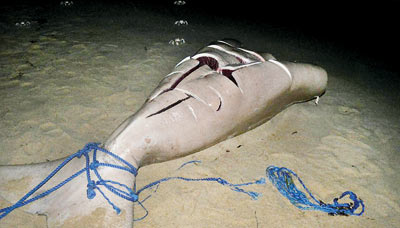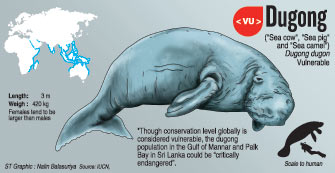News
Murder of a mermaid
Police are investigating the tragic killing of a dugong, the rare creature possibly believed to be a “mermaid” in olden times, in Mannar after the Navy came across a group of fishermen chopping up the mammal’s flesh on South Bar beach.
A local resident, Mohammed Haleem, said the Navy handed over the culprits to police and wildlife officers last week, and that they are out on bail.

Carcass of slain dugong in Mannar – photo by Mohamed Haleem
Dugongs are sometimes hunted but they also fall victim by being inadvertently included in fishing catches or drowning after being entangled in mist fishing nets or falling victim to dynamite fishing. The cause of the action that killed the Mannar dugong is unknown. Its vital organs have been sent for analysis.
Also known as sea cow or muhudu-ura (sea pig) in Sinhala, kadal pandi in Tamil, the dugong (Dugong dugon) is a marine mammal that primarily feeds on seagrass. Dugongs were hunted openly for their flesh and oil decades ago and their population plummetted.
In the 1970s, legal sanctions to protect dugongs were incorporated into legislation but rarely enforced. It is a known secret that still several animals are still killed annually, researcher Dr.Ranil Nanayakkara said.
The Gulf of Mannar and Palk Bay are the last known hideout in Sri Lanka and India for these elusive beings. The International Union for the Conservation of Nature (IUCN) Red List on threatened species categorises the dugong as “vulnerable to extinction”.
The dugong population in the Gulf of Mannar and Palk Bay in Sri Lanka could be “critically endangered”, points out the IUCN Sri Lanka’s country office’s Marine and Coastal Thematic Area Coordinator Arjan Rajasuriya.
| A mermaid related to an elephant The dugong, referred to as a sea cow, sea pig and even sea camel by different communities, is scientifically close to elephants. These mammals can stay underwater for six minutes without surfacing. |
In global terms, there are more stable dugong populations in places such as off Australia but if quick action is not taken the species’ future is indeed bleak in our local waters.
Dugongs are long-lived, and animals as much as 70 years of age has been recorded. But it is a slow breeder, giving birth to a single calf after an 18-month pregnancy. The mother dugong then looks after the calf for more than one and half years. So the kiling of even a few dugongs can have serious implications.
The United Nations Environment Programme (UNEP) confirms that the dugong is already extinct in several island states and suffering steep declines in at least a third of the areas where it is found.
It is ironic that the dugong at Mannar was killed just when a new project to protect dugongs and their seagrass ecosystem had begun, Mr. Rajasuriya said.
| Dynamite fishing poses grave threat Illegal dynamite fishing is common on many parts of the east coast, and a marine researcher said his team heard dynamite blasts almost every day while surveying the Vankalai coral reef, located in dugong habitat.  Vankalai reef destruction from blast fishing – photo by Arjan Rajasuriya, Coordinator, Marine and Coastal Thematic Area, IUCN Blast fishing Arjan Rajasuriya, Coordinator of the International Union for the Conservation of Nature’s (IUCN) Marine and Coastal Thematic Area, said dynamite fishing occurs particularly in around Errakkandy, north of Nilaweli, and around Batticaloa and Kalmunai. It is also commonly practised by fishermen in the Palk Bay and Gulf of Mannar, Mr. Rajasuriya said. |
Sri Lanka signed the Memorandum of Understanding (MOU) with UNEP and the Convention of Migratory Species (CMS) in 2012 to protect dugong through the Dugong and Seagrass Ecosystem Conservation project. The project’s Inception Workshop is scheduled for next month.


